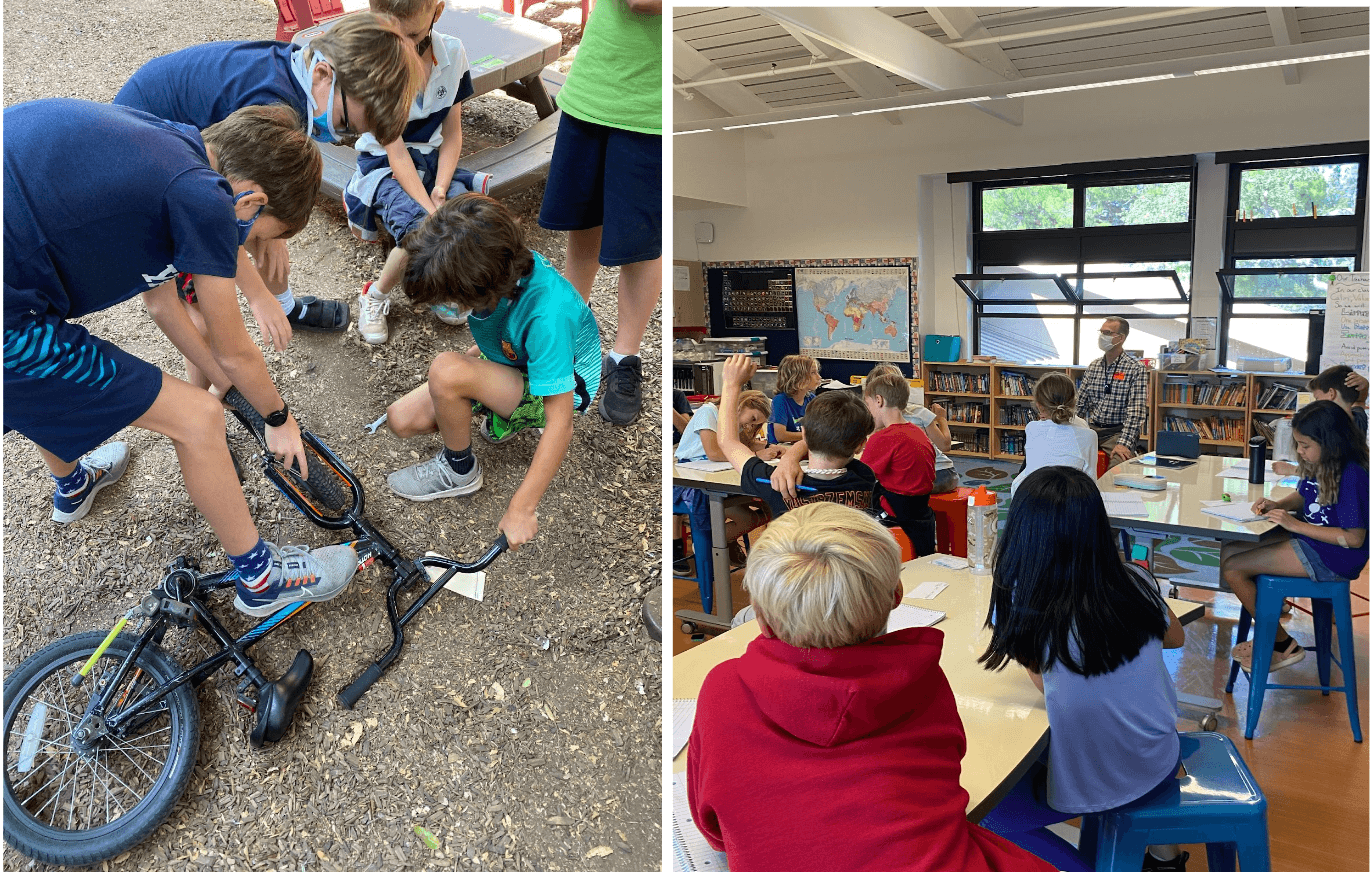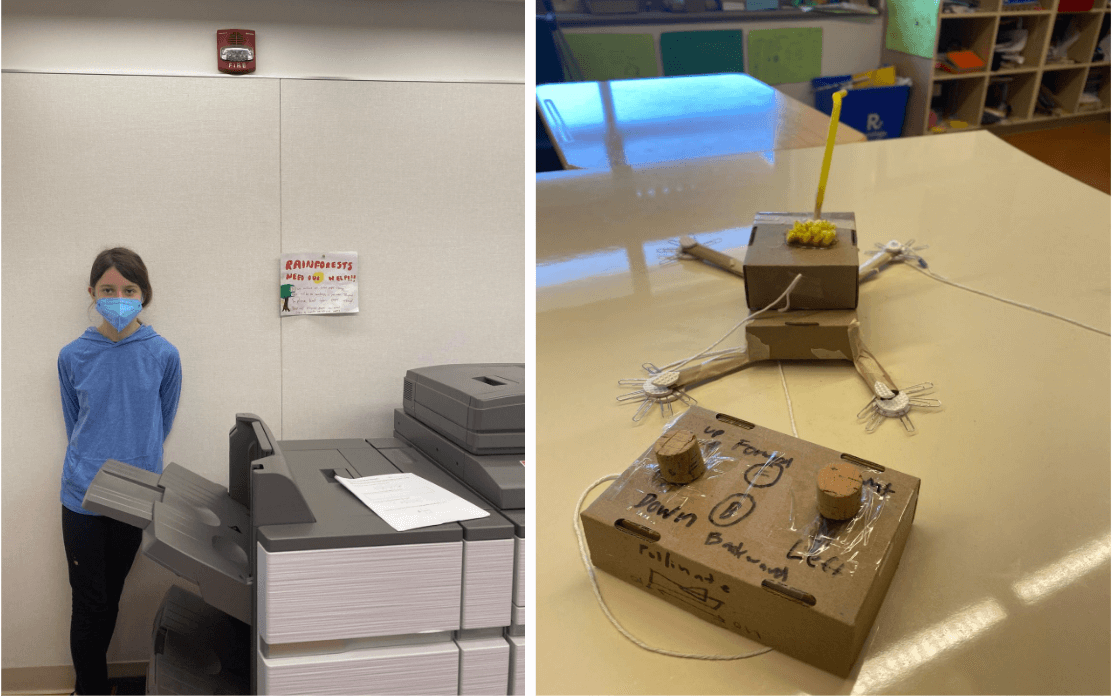In August 2020, I had returned to the classroom after a four-year term as a TOSA (teacher on special assignment) for Menlo Park City School District. In my TOSA time, I had learned a lot about innovative, data-driven, and student-centered learning. I saw the most energy in authentic problem solving and student-driven activism. My partner, Alicia Peyton, and I wrote and successfully implemented environmental project-based learnings (PBLs), which had a positive impact on our community. It was amazing to see the level of engagement and passion that went into these PBLs, and I was excited to get back into the classroom to start this work with my own students.
In that first year back in the classroom, we were contending with a pandemic; however, we were also noticing and wondering about different environmental issues. As the Earth healed in some ways, new plastics were everywhere. Students wanted to know why the sky was so dark and fires were so widespread. At the end of that school year, I felt an urgency to determine how I could intentionally bring climate change teaching, learning, and activism into my next school year. Sprinkling it in here and there just didn’t feel like enough.
That summer I joined the Environmental Solutionary Teacher Fellowship (ESTF), where teachers from all over expressed their own feelings of urgency to teach about climate change and environmental activism. The best part about joining the ESTF was finding that I was not alone. I could finally face the reality of climate change with a community. The workshops were so thoughtfully planned and included trauma-informed practices. I often learned as much from how the workshop was structured as I did from the content itself. The summer institute was packed with information, some of it very hard to come to terms with. Our leaders were empathetic about how much information we were ingesting and careful to keep us from environmental despair, just as we would need to thread that needle with our own students. We were introduced to solutionary teaching—finally, a way to bring hope! I was also thrilled to see the connections to design thinking. By the end of the summer institute, I was fired up. I knew I wanted to change the whole year ahead.
Last year I decided to jump in and get messy, rewriting my year as I went. At Back to School Night, I let the parents know that we are solutionaries, and our year would be focused on environmental activism—and that we welcomed their help. I showed some of the alarming graphs and information so that I could get them “into the red” as well. In class we made decisions together—do we need to laminate the name tags this year? Do we need to photocopy this? From there, the year bloomed. For example, we had a parent volunteer help us do a service project with the Silicon Valley Bike Exchange. Climate scientist Dave Fork became our mentor for our climate change design challenge. Environmental themes were weaved throughout the year in all subject areas: We focused our persuasive writing and research around climate change topics, and we adjusted our weather unit in reading to include environmental themes. I was thrilled to see the level of engagement in parents and students around this work.

In the ESTF, we were also given the opportunity to work with a senior fellow coach. It felt so good to have someone to collaborate with that was as passionate about this work as I was. She really listened and cheered me on, even when I thought my idea might be crazy. Without her support, I am not sure I would have reached as high as I did last year. Courageous work like this is best done with a supportive community.
The ESTF works to bring in a variety of partners, from the local community and beyond. That was amazing to me—all of these people want to help us? And they do, and the information and resources out there are outstanding. A big focus of the ESTF is to partner teachers with organizations that will help them lighten their teaching load. There are so many organizations (such as Youngzine, Environmental Volunteers, Recology, and Youth vs. Apocalypse) that want to come to schools and make environmental learning come alive. These organizations focus on environmental and social justice. Sometimes the hardest part was whittling down the resources and partners that we would include in our year.
Last year felt like a big success. I was even given a San Mateo County Office of Education Changemaker award! My students made changes in our school and community and really took on their role as solutionaries. Students sent letters to lawmakers, created environmental posters (out of recycled paper) to put by the copy machines, and much more. All students designed prototypes for climate change mitigation inventions—even entering them in nationwide competitions! I am a senior fellow this year. Now that I have finished a year of on-the-fly teaching, changing, and writing, I can iterate on what I did last year. The summer institute this year helped me focus: I learned to write my environmental narrative, zero in on local environmental and social justice issues, and use case studies in my teaching. I took away so much from this year’s summer institute and have made changes as I teach this year.

This year has also been a learning and growing experience. My consistent hope with this work is to share it with teachers in an organized and approachable way. In the ESTF Partner Fair this year, I met a young author named Sophia Qin, who wrote Becoming Earth 2.0. Our fourth-grade team elected to have her book be our “Act of Courageous Writing” community-read book. Additionally, one of my teammates and I decided to use her book to write a climate change unit. In this unit we examine the causes, effects, and possible solutions for climate change. It was an opportunity to finally go through the vast resources from the ESTF and attach them in an intentional and organized way for teachers. I will continue making environmental action and awareness the main thread of my school year; however, with this unit, teachers can implement at their own pace. Sophia Qin will also be coming to speak to our fourth graders about her environmental activism and courageous writing!
The ESTF embraces so many of the things I look for as a teacher: community, innovation, compassion, passion, challenge, and accountability. This community has helped me grow as a teacher and as a solutionary. The ESTF helps teachers and kids not just talk the environmental talk, but truly walk the walk.


One Response
Wow! What a wonderful and much-needed approach to climate change and education. I applaud you and your determination to understand climate change, and more importantly, how to become actively engaged in changing behaviors and thinking to make a difference. The real beauty is that you are teaching and learning these important lessons with your students and familes as future caretakers of this world. THANK YOU!